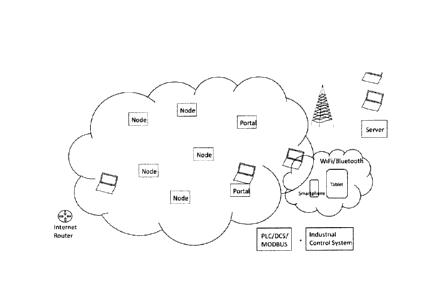Une partie des informations de ce site Web a été fournie par des sources externes. Le gouvernement du Canada n'assume aucune responsabilité concernant la précision, l'actualité ou la fiabilité des informations fournies par les sources externes. Les utilisateurs qui désirent employer cette information devraient consulter directement la source des informations. Le contenu fourni par les sources externes n'est pas assujetti aux exigences sur les langues officielles, la protection des renseignements personnels et l'accessibilité.
L'apparition de différences dans le texte et l'image des Revendications et de l'Abrégé dépend du moment auquel le document est publié. Les textes des Revendications et de l'Abrégé sont affichés :
| (12) Demande de brevet: | (11) CA 3048286 |
|---|---|
| (54) Titre français: | SYSTEME DE SURVEILLANCE DYNAMIQUE DE PIPELINE ET D`EQUIPEMENT ET PROCEDE CONNEXE |
| (54) Titre anglais: | PIPELINE AND EQUIPMENT DYNAMIC MONITORING SYSTEM AND METHOD THEREFOR |
| Statut: | Conforme |
| (51) Classification internationale des brevets (CIB): |
|
|---|---|
| (72) Inventeurs : |
|
| (73) Titulaires : |
|
| (71) Demandeurs : |
|
| (74) Agent: | |
| (74) Co-agent: | |
| (45) Délivré: | |
| (22) Date de dépôt: | 2019-06-28 |
| (41) Mise à la disponibilité du public: | 2020-12-28 |
| Licence disponible: | S.O. |
| (25) Langue des documents déposés: | Anglais |
| Traité de coopération en matière de brevets (PCT): | Non |
|---|
| (30) Données de priorité de la demande: | S.O. |
|---|
A vibration-analysis based system and methods for analyzing pipeline flow
dynamics, pipeline integrity and equipment predictive maintenance measures
obtained
from an integrated vibration array detection, data transmission, network
server data
processing, database management, patterns learning, patterns recognition and
user
interface. The system disclosed herein may be used for fatigue stress induced
cracking,
liquid slugging detection, geohazard monitoring, transient monitoring, pigging
progress
tracking and pig location tracking, volumetric evaluations, equipment failure
analysis and
predictive maintenance
Note : Les revendications sont présentées dans la langue officielle dans laquelle elles ont été soumises.
Note : Les descriptions sont présentées dans la langue officielle dans laquelle elles ont été soumises.

Pour une meilleure compréhension de l'état de la demande ou brevet qui figure sur cette page, la rubrique Mise en garde , et les descriptions de Brevet , États administratifs , Taxes périodiques et Historique des paiements devraient être consultées.
| Titre | Date |
|---|---|
| Date de délivrance prévu | Non disponible |
| (22) Dépôt | 2019-06-28 |
| (41) Mise à la disponibilité du public | 2020-12-28 |
Il n'y a pas d'historique d'abandonnement
Dernier paiement au montant de 100,00 $ a été reçu le 2022-08-11
Montants des taxes pour le maintien en état à venir
| Description | Date | Montant |
|---|---|---|
| Prochain paiement si taxe applicable aux petites entités | 2025-06-30 | 100,00 $ |
| Prochain paiement si taxe générale | 2025-06-30 | 277,00 $ |
Avis : Si le paiement en totalité n'a pas été reçu au plus tard à la date indiquée, une taxe supplémentaire peut être imposée, soit une des taxes suivantes :
Les taxes sur les brevets sont ajustées au 1er janvier de chaque année. Les montants ci-dessus sont les montants actuels s'ils sont reçus au plus tard le 31 décembre de l'année en cours.
Veuillez vous référer à la page web des
taxes sur les brevets
de l'OPIC pour voir tous les montants actuels des taxes.
| Type de taxes | Anniversaire | Échéance | Montant payé | Date payée |
|---|---|---|---|---|
| Le dépôt d'une demande de brevet | 200,00 $ | 2019-06-28 | ||
| Taxe de maintien en état - Demande - nouvelle loi | 2 | 2021-06-28 | 50,00 $ | 2021-08-11 |
| Surtaxe pour omission de payer taxe de maintien en état pour demande | 2021-08-11 | 150,00 $ | 2021-08-11 | |
| Taxe de maintien en état - Demande - nouvelle loi | 3 | 2022-06-28 | 50,00 $ | 2022-08-11 |
| Surtaxe pour omission de payer taxe de maintien en état pour demande | 2022-08-11 | 150,00 $ | 2022-08-11 | |
| Taxe de maintien en état - Demande - nouvelle loi | 4 | 2023-06-28 | 50,00 $ | 2022-08-11 |
| Taxe de maintien en état - Demande - nouvelle loi | 5 | 2024-06-28 | 100,00 $ | 2022-08-11 |
Les titulaires actuels et antérieures au dossier sont affichés en ordre alphabétique.
| Titulaires actuels au dossier |
|---|
| HOWE, WILSON |
| Titulaires antérieures au dossier |
|---|
| S.O. |